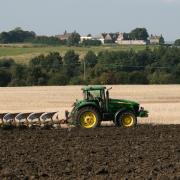 |
|
Most farm operations currently depend on fossil fuel use. Photo: Jeff Piper. |
Learn many strategies for improving energy efficiency, and the cheapest and easiest way to reduce energy costs on the farm.
Table of Contents
- The Growing Interest in Energy Conservation and Generation on the Farm
- Energy Conservation and Efficiency
- Renewable Energy
The Growing Interest in Energy Conservation and Generation on the Farm
In the last few years, interest in alternative energy and energy conservation has skyrocketed due to unstable fuel prices and the desire to move toward renewable and sustainable energy sources. At the same time, technologies to conserve energy as well as convert feedstocks to biodiesel and ethanol have improved significantly.
Across America, farms are generating their own energy using wind turbines, solar panels, or anaerobic digesters, with some selling the excess electricity back to the grid. Other producers are experimenting with on-farm biodiesel and ethanol production, or researching new energy-related crops and business opportunities in anticipation of developing cellulosic biofuel technology and markets.
Farm energy can generally be divided into:
- Energy Conservation and Efficiency
- Renewable Energy
Energy Conservation and Efficiency
Conserving energy and improving energy efficiency is not only good for the environment – it reduces dependence on fossil fuels and curbs greenhouse gas emissions – but also for the pocketbook, saving farmers money. Fifteen percent of agricultural production costs are energy related, according to the U.S. Department of Agriculture (USDA), and as energy prices rise, these costs claim an ever bigger portion of farm budgets. The quickest, cheapest, and cleanest way to lower these costs, as well as cut non-renewable energy consumption, is by improving energy efficiency.
Many farms have captured energy savings by improving tractor and field operation efficiency, improving machinery maintenance, updating to new dairy cooling or heating equipment, and using high-efficiency motors, fans, and/or lighting.
Significant energy savings can also be found through improved insulation, proper siting and design of farm buildings, and energy efficient greenhouses. A shift in many agricultural practices such as reducing or eliminating tillage, converting to grass-based livestock operations, or switching to micro-irrigation can also lead to big energy and financial savings.

Renewable Energy
Renewable energy is energy that is generated from natural resources, including sunlight, wind, rain, geothermal, and biomass and that can be replenished at the same rate as it is used. Renewable energy resources vary widely by region. For example, the states in the Midwest have excellent wind potential. Although solar projects are viable in all parts of the United States, the South and West have outstanding solar radiation. The same holds for biofuel production: oilseed crops for biodiesel show excellent promise in the Pacific Northwest and Northeastern states, while switchgrass, a high-yielding and relatively easy-to-grow crop and promising cellulosic feedstock, appears well suited to the South and Midwest.
Farmers can generate extra income by producing renewable energy to contribute to the grid. For example, they can use turbines to generate wind power to sell back to a utility or grow grasses and oilseeds as feedstocks for ethanol and biodiesel.
Farmers can also develop renewable energy for their own use, installing small-scale solar or wind systems or growing and converting biofuel crops for their own farming operations. These projects not only save on fuel and utility costs but improve self-sufficiency and protect farms from fluctuating oil and diesel prices.
For Further Reading
- Farm Energy Alternatives website from ATTRA, the National Sustainable Agriculture Information Service.
- An Introduction to Bioenergy: Feedstocks, Processes, and Products. Non-technical overview of bioenergy feedstock production with discussion on how bioenergy is made. ATTRA, the National Sustainable Agriculture Information Service, 2010.
Contributors to This Article
- Mike Morris, National Sustainable Agriculture Information Service (ATTRA), National Center for Appropriate Technology (NCAT)
- Diana Friedman, SARE (Sustainable Agriculture Research and Education)
- Michael Bomford, Kentucky State University


